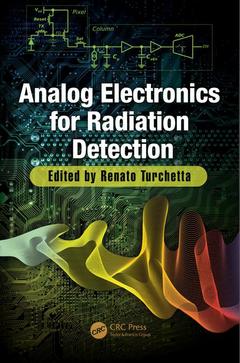Description
Analog Electronics for Radiation Detection
Devices, Circuits, and Systems Series
Language: English
Subjects for Analog Electronics for Radiation Detection:
Keywords
SiGe Heterojunction Bipolar Transistor; Three-Dimensional Interconnect; CMOS Image Sensor; 3D Interconnect; Charge Sensitive Amplifier; Complementary Metal–Oxide Semiconductor Image Sensors; Power Consumption; CMOS Image Sensors; Geiger Mode Avalanche Photodiode; Pixel Detectors; SiPM; Silicon Photomultipliers; CMOS Sensor; TDC; Photon Detection Efficiency; Time to Digital Converters; DCR; A to D Converters; CdTe Detectors; A/D Converters; ADC Architecture; ADC; Afterpulse Probability; Analog to Digital Converters; Folded Cascode Amplifier; Semiconductor Detectors; ADC Resolution; Low-Noise Detectors; 4T Pixel; Readout Electronics; CMOS Image; Front-End Electronics; MOS Transistor; Microelectronics; Energy Resolution; Analog Electronics; Quench Resistor; Particle Detectors; Flicker Noise; Radiation Detectors; Excess Bias Voltage; Thomas Noulis; Excess Bias; Ivan Peric; Front End Electronics; Juan A; Leñero-Bardallo; Readout ASIC; gel Rodríguez-Vuez; European X-ray Free Electron Laser; Adi Xhakoni; Georges Gielen; Yasuo Arai; Leonardo Abbene; Gaetano Gerardi; Fabio Principato; Carl Jackson; Kevin O'Neill; Liam Wall; Brian McGarvey; Edoardo Charbon; Chockalingam Veerappan; Cristoforo Marzocca; Fabio Ciciriello; Francesco Corsi; Francesco Licciulli; Gianvito Matarrese; Nicola Guerrini; Paul Seller
Publication date: 04-2016
· 15.6x23.4 cm · Hardback
Publication date: 04-2018
· 15.6x23.4 cm · Paperback
Description
/li>Contents
/li>Biography
/li>
Analog Electronics for Radiation Detection showcases the latest advances in readout electronics for particle, or radiation, detectors. Featuring chapters written by international experts in their respective fields, this authoritative text:
- Defines the main design parameters of front-end circuitry developed in microelectronics technologies
- Explains the basis for the use of complementary metal?oxide semiconductor (CMOS) image sensors for the detection of charged particles and other non-consumer applications
- Delivers an in-depth review of analog-to-digital converters (ADCs), evaluating the pros and cons of ADCs integrated at the pixel, column, and per-chip levels
- Describes incremental sigma?delta ADCs, time-to-digital converter (TDC) architectures, and digital pulse-processing techniques complementary to analog processing
- Examines the fundamental parameters and front-end types associated with silicon photomultipliers used for single visible-light photon detection
- Discusses pixel sensors with per-pixel TDCs, channel density challenges, and emerging 3D technologies interconnecting detectors and electronics
Thus, Analog Electronics for Radiation Detection provides a single source for state-of-the-art information on analog electronics for the readout of radiation detectors.
Integrated Analog Signal Processing Readout Front Ends for Particle Detectors. Analog Electronics for HVCMOS Sensors. Analog Electronics for Radiation Detection. Low-Noise Detectors through Incremental Sigma–Delta ADCs. Time-to-Digital Conversion. Digital Pulse-Processing Techniques for X-Ray and Gamma-Ray Semiconductor Detectors. Silicon Photomultipliers for High-Performance Scintillation Crystal Readout Applications. Designing Photon-Counting, Wide-Spectrum Optical Radiation Detectors in CMOS-Compatible Technologies. Front-End Electronics for Silicon Photomultipliers. CMOS Image Sensors for Radiation Detection. Technology Needs for Modular Pixel Detectors.
Renato Turchetta is leading the development of high-end complementary metal–oxide semiconductor (CMOS) image sensors at the Rutherford Appleton Laboratory in Didcot, UK, the largest national laboratory in the United Kingdom owned and operated by the Science and Technology Facilities Council (STFC). He earned his master’s degree (Laurea) from the University of Milan, Italy, in 1988 and his PhD in applied physics from the University of Strasbourg, France, in 1991. He worked as an assistant professor there until 1999, the year when he moved to the Rutherford Appleton Laboratory. In his career, he has worked on the development of semiconductor detectors and their readout microelectronics before focusing on CMOS image sensors. He has worked in this area for more than 15 years. He is the author and coauthor of several patents and more than 100 papers that were published in international journals. He is currently an acting member of the scientific committee for Image Sensors Europe, the International Congress on High-Speed Imaging and Photonics, and the Pixel and CPIX conferences.




